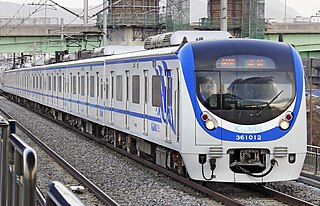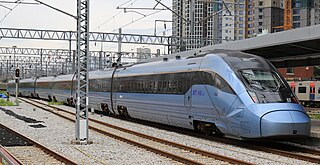
The Seoul Metropolitan Subway is a metropolitan railway system consisting of 23 rapid transit, light metro, commuter rail and people mover lines located in northwest South Korea. The system serves most of the Seoul Metropolitan Area including the Incheon metropolis and satellite cities in Gyeonggi province. Some regional lines in the network stretch out beyond the Seoul Metropolitan Area to rural areas in northern Chungnam province and western Gangwon province, that lie over 100 km (62 mi) away from the capital.

The Korea Railroad Corporation, branded as KORAIL, is the national railway operator in South Korea. Currently, KORAIL is a public corporation, managed by Ministry of Land, Infrastructure and Transportation.

Seoul Subway Line 1 of the Seoul Metropolitan Subway is a rapid transit and commuter rail line which links central Seoul, South Korea to Soyosan Station in the northeast, Incheon in the southwest, and Sinchang via Suwon and Cheonan in the south. The central underground portion of this rail line is the oldest subway section in the Seoul Metropolitan Subway system. Its branches and services cover a large part of the Seoul Capital Area; totaling 200.60 km (124.65 mi) in route length.

Hyundai Rotem is a South Korean company that manufactures rolling stock, defense products and plant equipment. It is a part of the Hyundai Motor Group. Its name was changed from Rotem to Hyundai Rotem in December 2007 to reflect the parent company.

Seoul Subway Line 3 of the Seoul Metropolitan Subway is a rapid transit service that connects Eunpyeong District to Gangnam and southeastern Seoul. Most trains head further northwest to serve Goyang via the Ilsan Line. In 2021, the Seoul Metro operated section had an annual ridership of 295,930,000 or 810,767 passengers per day.

Seoul Subway Line 4 of the Seoul Metropolitan Subway is a long line crossing from the southwest to the northeast across the Seoul National Capital Area. The central section in Seoul City is operated by Seoul Metro with some trains offering through service to Korail's Ansan and Gwacheon Lines. The southern terminus (Oido) is in Jeongwang 4-dong, Siheung City, and the northern terminus (Jinjeop) is in Jinjeop-eup, Namyangju-si, Gyeonggi-do. In 2022, the Seoul Metro operated section had an annual ridership of 219,587,000 or about 601,608 passengers per day.

The Saemaeul-ho, formerly known as the Saemaul-ho and Saemaul Express, is a class of train operated by Korail, the national railroad of South Korea, since February 8, 1969. Before the introduction of the KTX express trains, the Saemaeul-ho was the fastest class of trains in South Korea, making the journey from Seoul to Busan in less than 5 hours. Saemaeul trains operated on several lines, but they now only operate on the Janghang Line.

The Korail Class 8200 is a South Korean electric locomotive operated by Korail. This locomotive has head-end power capabilities in place of a dynamo car, which could be used with up to 12 passenger cars.

The Korail Class 1000 was a series of electric multiple units built in Seoul, South Korea for Seoul Subway Line 1. The cars were built in and entered service between 1974 and 1997. They were gradually retired from the late 1990s to 2020 by newer electric multiple unit trains.

The Korail Class 311000 trains, some train of which were formerly identified as Korail Class 5000 trains, are commuter electric multiple units in South Korea used on Seoul Subway Line 1. Class 311000 trains were manufactured and delivered between 1996 and 2006, and again from 2012 to 2014 to expand service on the Gyeongbu Line and the Gyeongwon Line, and to replace older trains.

The Gyeongui–Jungang Line is a commuter rail service of the Seoul Metropolitan Subway system, operating on trackage from the Gyeongui Line and the Jungang Line.

The Korail Class 321000 trains, created from an assortment of Class 5000, Class 6000, and new cars, are commuter electric multiple units in South Korea used on the Gyeongui-Jungang Line. Class 321000 trains were manufactured and delivered between 2006–2009 to provide service on what was known as the Jungang Line at the time, and to address progressing extensions starting from the extension to Paldang Station.

The Korail Class 331000 trains are commuter electric multiple units in South Korea used on the Gyeongui·Jungang Line. Class 331000 trains were manufactured and delivered in 2009 and from 2012 to 2014 to provide service on the Gyeongui Line and to address progressing extensions starting from the extension to Gongdeok Station.

The Korail Class 361000 trains are commuter electric multiple units in South Korea used on the Gyeongchun Line. Class 361000 trains were manufactured and delivered in 2010 to provide service on the Gyeongchun Line.

The Korail Class 371000 trains are commuter electric multiple units in South Korea used on the Gyeonggang Line.

The Korail Class 341000 trains, formerly identified as Korail Class 2000 trains, are commuter electric multiple units in South Korea used on Seoul Subway Line 4. Class 341000 trains were manufactured and delivered between 1993 and 1999 to expand service on the Gwacheon Line and the Ansan Line sections of Line 4.

The Korail Class 351000 trains, formerly identified as Korail Class 2000 trains, are commuter electric multiple units in South Korea used on Suin-Bundang Line. Class 351000 trains were manufactured and delivered between 1993.

The KTX-Eum or Korail Class 150000 is a South Korean high-speed electric multiple unit train manufactured by Hyundai Rotem and operated by Korail. The word 'eum' in Korean means 'uniting through connection'. This name was selected by members of the public, and expresses the desire to connect regions, people, and happiness through trains.

The Suin–Bundang Line is a commuter rail service of the Seoul Metropolitan Subway system, operating on trackage from the Suin Line and the Bundang Line. Operation began on September 12, 2020.

Intercity Train eXpress-Cheongchun abbreviated as ITX-Cheongchun (Korean: ITX-청춘) is a class of train operated by Korail, the national railroad of South Korea, it was introduced on February 28, 2012. ITX-Cheongchun is the successor of the Gyeongchun Line Mugunghwa-ho which operated until December 2010. It is the only Limited express in Korea, and offers services comparable to those in Japan. In fact, it is known to benchmarking Japan's Limited express. Also, Korea's first double-decker coach was applied. This train connects Seoul, Guri, Namyangju, Gapyeong and Chuncheon. The ITX-Cheongchun trains have a faster average speed of 180 kilometers per hour.


















